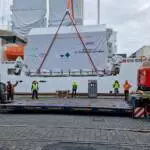Top Stories Tamfitronics

TAMPA, Fla. — Sentinel-2C is ready to be shipped from Germany for a two-week trip across the Atlantic Ocean to the European spaceport in French Guiana, where Europe’s latest Earth science satellite is due to launch on the final flight of the original version of the Vega rocket.
Manufacturer Airbus said July 3 it had loaded the satellite onto Canopée, a sail-assisted cargo ship designed specifically to transport components for Europe’s Ariane 6 rocket.
Like its Airbus-built predecessors Sentinel-2A and -2B — launched in 2015 and 2017, respectively — Sentinel-2C’s payload is designed to generate optical images from the visible to the shortwave infrared region of electromagnetic spectrum.
Each Sentinel-2 satellite collects 1.5 terabytes of data per day following onboard compression, supporting applications ranging from tracking land use to environmental monitoring.
Airbus said the 1,100-kilogram Sentinel-2C spacecraft would provide continuous imaging in 13 spectral bands from an altitude of 786 kilometers above Earth. With a swath width of 290 kilometers, the company said the payload would provide images with resolutions of 10, 20 or 60 meters.
Sentinel-2C would ultimately replace Sentinel-2A, which is identical to Sentinel-2B. Airbus is also under contract to provide the Sentinel-2D satellite to replace Sentinel-2B and ensure data continuity beyond 2035.
The satellites are part of Copernicus, the Earth observation component of the European Union’s space program that leverages various technologies in orbit.

“About half of the data used to assess and monitor the impact of climate change on Earth is actually delivered by satellites,” Marc Steckling, Airbus head of Earth observation, science and exploration, said in a statement.
“The Copernicus Sentinel-2 satellites have provided valuable climate information to scientists since 2015 and Sentinel-2C will ensure continuity. Additionally, they have also made monitoring marine litter from space a reality, a significant achievement considering how critical this issue has become.”
Arianespace’s next-generation medium-lift Vega C rocket successfully launched a handful of satellites in its July 2022 maiden flight.
However, the rocket failed to reach orbit during its second mission five months later — destroying two Airbus Pléiades Neo imaging satellites in the process — and has been grounded since.
The European Space Agency said in May it is preparing to return Vega C to service before the end of 2024.
The final flight of the original version of the Vega rocket was also due to launch early this year before running into a problem with its upper stage.
Following its own series of setbacks, the first flight of Arianespace’s Ariane 6 heavy-lift rocket, the successor to Ariane 5, is expected to take place July 9 from French Guiana.
Jason Rainbow writes about satellite telecom, space finance and commercial markets for SpaceNews. He has spent more than a decade covering the global space industry as a business journalist. Previously, he was Group Editor-in-Chief for Finance Information…More by Jason Rainbow




